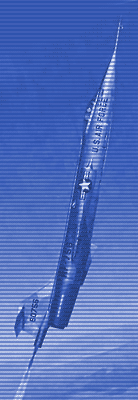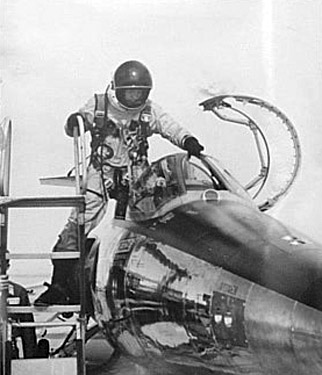The Mission > home

|
|
|
|
|
|
 |
The Mission click on the links below for more of the story...
|
||
6 Surprise…Surprise!
The Air Force test program began as I started flying the aircraft from the factory to Edwards. I would perform another zoom flight test each time I picked up one of the aircraft to move from Palmdale to Edwards, which began our full qualification of the AST for its primary role as a space-plane trainer. The flight depended on the “experience” of the particular aircraft. When I flew out #756 in that manner, I was able to fly its first zoom, since it already had 18 test flights when I took off. I got it to somewhere around a peak altitude of 118 to 119 thousand feet, the typical range of my zooms. Wind, temperature and density at altitude had impact on the zoom performance, but we had no data to consider these. Some were later developed for ARPS use, however, not on max zooms. The apogee on this flight was around my average, so I expected an average reentry. As I built up speed to nearly Mach 2.2 on the descending dive an event happened so suddenly and was so startling that I truly expected that I had bought the farm. I was at the correct angle of attack of 16-degrees, so should have been dynamically stable, but the airplane acted like it was going unstable. We began a rapid and harsh yaw cycle that had all the symptoms and in that split second my heart got close to my mouth. Maybe it was just the pucker reverberating from my seat. With dynamic lateral instability at these conditions an aircraft becomes uncontrollable with increasingly wild yaw/roll excursions until it tears to pieces, in very short order. This is most apt to happen as the angle of attack and speed increase and the airplane begins to lose its margin of directional stability, so we were dealing in that flight regime and the risk was present. There was no reaction possible to reduce speed at this point in a max zoom, and I had been aware of that coffin corner. From the top of the flight, down, the jet and rocket were both shut off so there was no way to reduce speed except deploy speed brakes or increase alpha. Since both of those would increase the risk, badly, I could only hold on. The wildly swinging nose continued for a while, without getting worse, a sure sign it was not a divergent instability and a great relief. Then it ceased as quickly as it commenced. Just as suddenly a second anomaly appeared at a lower altitude in the dive. One hell of a rumbling began below and behind me, which sounded like a serious engine failure, but the jet had been shutdown at about 86,000 feet on my way up, a long time before! This too subsided and the flight was normal thereafter. Lockheed folks, who were excellent engineers and very knowledgeable of the airplane concluded that the reason these occurred this time and not before was probably the atmospheric differences between my prior flights, e.g. density, temperature, and if we were that close to their occurrence then it would undoubtedly repeat on occasion, and be very unsettling to students. Angle of attack was an unchangeable limit, so I checked details on the cause and effects, which restricted me from using speed brakes. The airplane was redlined to Mach 1.6 in the brakes open position, but could be raised to 2.0 by limiting the extension angle of the brakes only by 2 degrees to 58. We were able to have small blocks machined and installed to limit the opening angle. Since I never got above 2.2 in the descent without them, it was clear with that limit we would never see these problems again, and I never did. Similarly, it was concluded that the engine compartment noise was caused by the lack of bypass flaps to unload the engine ducts. Originally all F-104s had these, but they were deactivated, so we located 3 sets from deactivated standard F-104s, and our crews installed and activated them. The analysis of cause of the ‘false instability’ was suggested to be swallowing of shock waves in one air intake with resultant unsymmetrical drag causing yaw, then a spilling effect and reversal of the process to the other intake. It was force driven, not instability driven. The second anomaly was another shock pressure induced event on the engine compartment. Neither situation ever reappeared after the two fixes were completed, even when I flew above design level. All of the 38 contractor test flights were conducted from Palmdale Airport, CA. The only plan for landing at Edwards was in case of dead stick landing, which did not occur on any of the 10 zooms between Jack and me. Later on, the third and final AST (#60762) was completed and I flew its functional flight test on the way from the Palmdale, California airport to Edwards A.F.B., its first flight since the single production test hop made by Lockheed. Then I was in full swing on the test program, with all three airplanes available. |
| previous section | next section |
